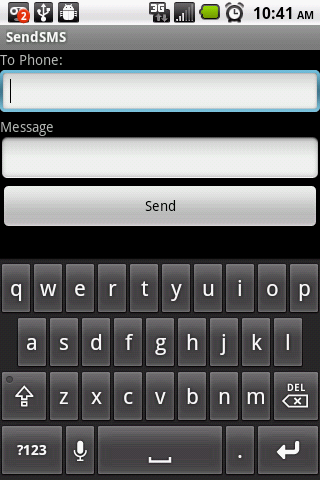We are going to make a text messaging app: two text fields, one for the phone number and message and of course a send button. Pictures of the interface below.

a simple interface for sending text messages
and of course there will also be an error message if the user decides to try to be smart.

The error message users will get if they don't comply.
The JAVA file: SendSMSActivity.java
As always I think my comments in the code are pretty self explanatory, so I’ll just give you the code
package com.example.sendsms;
// import everything you need
import android.app.Activity;
import android.app.PendingIntent;
import android.content.Intent;
import android.os.Bundle;
import android.telephony.SmsManager;
import android.view.View;
import android.widget.Button;
import android.widget.EditText;
import android.widget.Toast;
public class SendSMSActivity extends Activity {
Button sendButton;
EditText phoneTextField;
EditText msgTextField;
/** Called when the activity is first created. */
@Override
public void onCreate(Bundle savedInstanceState)
{
super.onCreate(savedInstanceState);
// load the layout
setContentView(R.layout.main);
// make message text field object
msgTextField = (EditText) findViewById(R.id.msgTextField);
// make send button object
sendButton = (Button) findViewById(R.id.sendButton);
// make phone number field object
phoneTextField = (EditText) findViewById(R.id.phoneTextField);
}
// this is the function that gets called when you click the button
public void send(View v)
{
// get the phone number from the phone number text field
String phoneNumber = phoneTextField.getText().toString();
// get the message from the message text box
String msg = msgTextField.getText().toString();
// make sure the fields are not empty
if (phoneNumber.length()>0 && msg.length()>0)
{
// call the sms manager
PendingIntent pi = PendingIntent.getActivity(this, 0,
new Intent(this, SendSMSActivity.class), 0);
SmsManager sms = SmsManager.getDefault();
// this is the function that does all the magic
sms.sendTextMessage(phoneNumber, null, msg, pi, null);
}
else
{
// display message if text fields are empty
Toast.makeText(getBaseContext(),"All field are required",Toast.LENGTH_SHORT).show();
}
}
}
The code can be easily modified to send automatic text messages.
The Layout File: main.xml
<?xml version="1.0" encoding="utf-8"?>
<LinearLayout xmlns:android="http://schemas.android.com/apk/res/android"
android:orientation="vertical"
android:layout_width="fill_parent"
android:layout_height="fill_parent"
>
<TextView
android:text="To Phone:"
android:layout_width="fill_parent"
android:layout_height="wrap_content"
/>
<EditText
android:id="@+id/phoneTextField"
android:layout_width="fill_parent"
android:layout_height="wrap_content"
/>
<TextView
android:text="Message"
android:layout_width="fill_parent"
android:layout_height="wrap_content"
/>
<EditText
android:id="@+id/msgTextField"
android:layout_width="fill_parent"
android:layout_height="wrap_content"
/>
<Button
android:text="Send"
android:id="@+id/sendButton"
android:layout_width="fill_parent"
android:layout_height="wrap_content"
android:onClick="send"
/>
</LinearLayout>
The Manifest File: AndroidManifest.xml
Notice the permission used to send sms, other than that it’s just the default manifest file.
<?xml version="1.0" encoding="utf-8"?>
<manifest xmlns:android="http://schemas.android.com/apk/res/android"
package="com.example.sendsms"
android:versionCode="1"
android:versionName="1.0">
<uses-sdk android:minSdkVersion="8" />
<uses-permission android:name="android.permission.SEND_SMS" />
<application android:icon="@drawable/icon" android:label="@string/app_name">
<activity android:name=".SendSMSActivity"
android:label="@string/app_name">
<intent-filter>
<action android:name="android.intent.action.MAIN" />
<category android:name="android.intent.category.LAUNCHER" />
</intent-filter>
</activity>
</application>
</manifest>